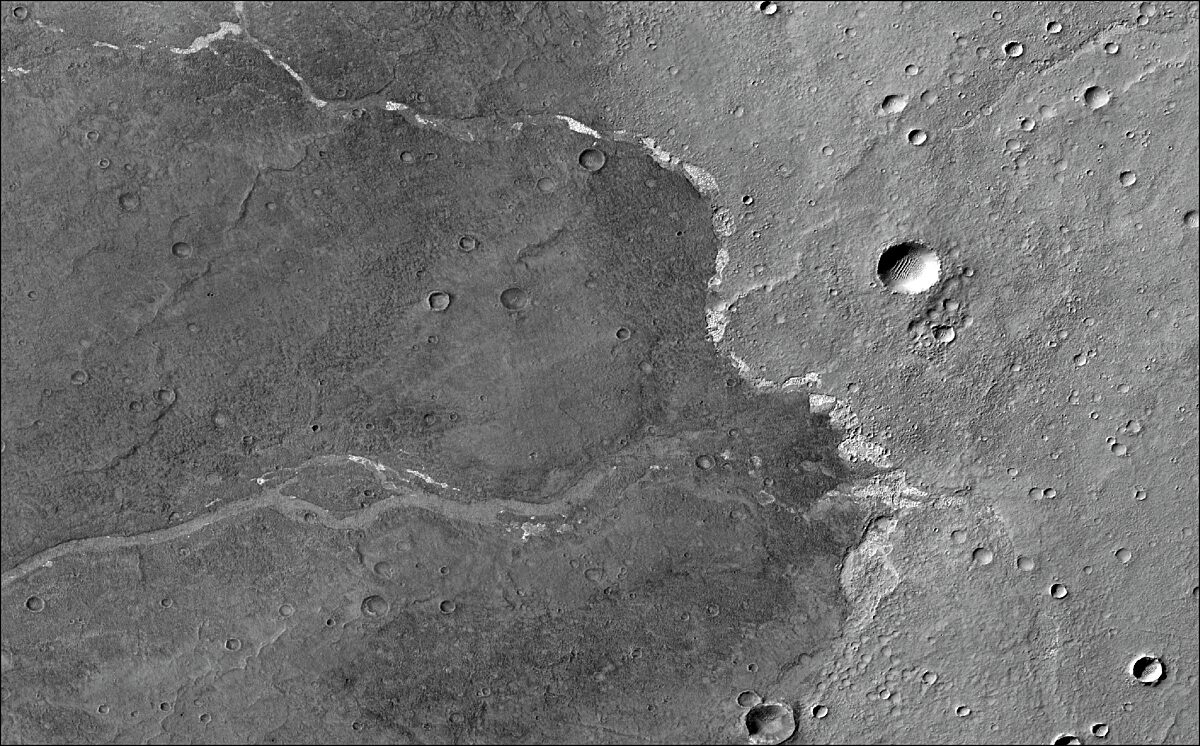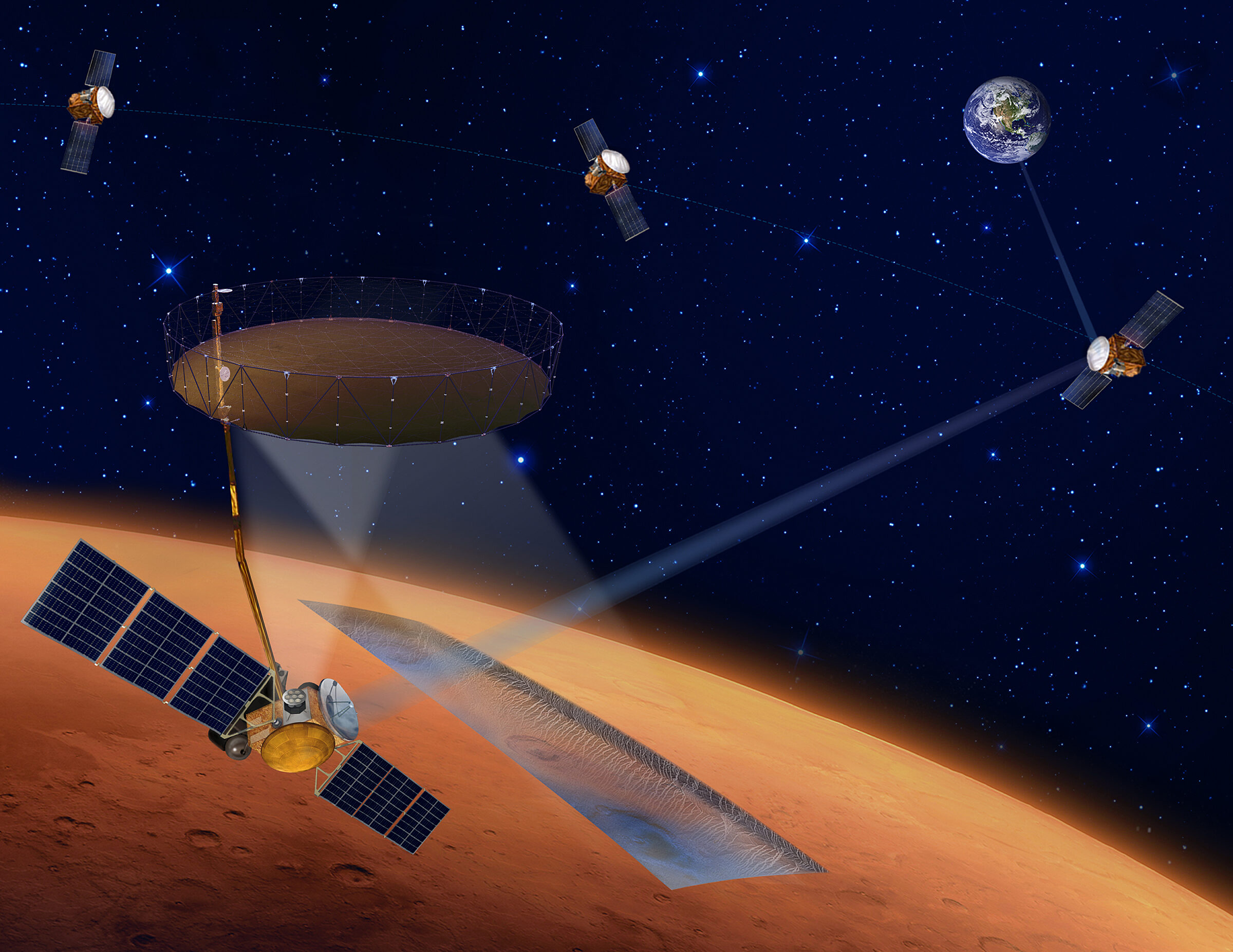Jason Davis • Oct 25, 2022
Your guide to water on Mars
Mars isn't the best place to quench your thirst, although it might have been a few billion years ago.
The red planet once had a global ocean, rivers, and lakes. Then, the solar wind — charged particles from the Sun — stripped away the Martian atmosphere. As the planet’s protective shield faded, all liquid water on the surface evaporated into space, merged with minerals, or fled underground to become water ice.
So where is all the leftover Martian water today? How does knowing where it is help scientists and would-be explorers?
The locations of Martian water are good places to search for past or even present life. Additionally, since it takes supply ships several months to travel between Earth and Mars, it behooves Martian astronauts to know where to find water that can be converted to rocket fuel, air, and drinking water.
Martian lakes?
A body of liquid water on Mars such as a lake would be a precious resource — and an area of deep scientific interest.
In 2018, scientists announced they had possibly found such a reservoir beneath Mars’ south polar cap. The European Space Agency’s Mars Express spacecraft used its radar to detect bright reflections coming from beneath the polar cap, indicating a potential subsurface lake.
On Earth, a similar body of water named Lake Vostok is buried 3.7 kilometers (2 miles) beneath Antarctica. Lake Vostok would ordinarily be too cold to stay liquid, but its high salt content keeps it from freezing. The lake is also chock-full of organisms.
Could something similar be happening on Mars? In order to keep from freezing, a lake beneath Mars’ south polar cap would have to be extremely salty, and possibly get some additional heating help from volcanic activity.

In 2021, scientists announced Mars Express had discovered more, similar bright spots at the south pole. Some are very close to the surface, where temperatures plunge to a frigid -63 degrees Celsius (-81 degrees Fahrenheit). No salty water could stay liquid in such a frigid environment.
In September 2022, two papers released within three days of each other offered conflicting support for and against the original Mars Express findings. One paper said the bright signal could have been caused by a very specific layering of minerals and frozen carbon dioxide, rather than liquid water.
Another paper took a closer look at the topography of the region using data from NASA’s Mars Global Surveyor spacecraft, which operated at Mars from 1997 to 2006. That paper said the terrain above the theorized Martian lake resembled regions seen above subsurface Earth lakes.
Small-scale liquid water

Another long-standing Martian water debate surrounds the 2015 detection of liquid water flowing down Martian slopes. Known as Recurring Slope Lineae, or RSL, the flows appear during warm seasons and fade during cool seasons. The excitement cooled off as alternative RSL theories emerged, including one that said sand, not water, was causing the flows.
Janice Bishop, a senior research scientist at the SETI Institute and NASA's Ames Research Center, thinks the answer may lie somewhere in between. She led a team that concluded salty water ice just beneath the surface may be melting and creating a slushy mix that flows down Martian slopes.
“I feel very confident about the microscale liquid-like water in some permafrost regions of Mars,” she told The Planetary Society.
Water ice

If you can’t fill up your Martian canteen with liquid water, your next best bet may be water ice.
"Ground ice is the best material to access for water resources on Mars, and surveying to understand its full extent, even when shallowly buried, is a key future measurement,” said Bethany Ehlmann, a professor of planetary science at the California Institute of Technology and the president of The Planetary Society.
Mars has approximately 5 million cubic kilometers (1.2 million cubic miles) of ice at or near the planet’s surface. Most lies in the planet’s northern and southern regions. That’s inconvenient, because it’s much easier to land and operate a spacecraft closer to the equator, where temperatures are warmer, the atmosphere is thicker in lower elevations, and the planet spins faster, making it easier to launch a rocket on a return trip to Earth.
In the Martian mid-latitudes between the equator and poles, an explorer might encounter ice buried less than a meter beneath the surface, and in some cases under just a light dusting of Martian soil. NASA’s Phoenix lander showed just how easy it is to find ice in this region in 2008.
The snow-white Martian polar caps are actually sheets of water ice and dust, stacked on top of each other like a layer cake. The cake’s frosting is a seasonal sheet of carbon dioxide — essentially dry ice. During each pole’s summer, the carbon dioxide sublimates, turning directly from a solid to a gas and producing Martian clouds. In winter, the carbon dioxide snows back onto the ice and dust layers, re-frosting the polar cake.
Water locked in minerals

Mars is rich in minerals that formed in water, and in some cases still hold water. These aptly named hydrated minerals can be found around the planet, as shown in maps made using data from NASA’s Mars Reconnaissance Orbiter and the European Space Agency’s Mars Express.
Knowing the location of these minerals is important for unpacking the planet’s watery history. Just like Earth, Mars likely got its water from asteroids and comets that bombarded its surface. Conditions may have been right for the red planet to be habitable from 4.1 to 3 billion years ago.
During that time, life could have taken hold in global oceans, rivers, and lakes. Liquid water may have flowed even longer, up until about 2 billion years ago, as evidenced by salty deposits left behind when the last of the planet’s water dried up.
Hydrated minerals are an important target for NASA’s Curiosity and Perseverance rovers. In September 2022 Perseverance investigated a rock formed by mud and sand as the lake in Jezero Crater evaporated. Curiosity, meanwhile, is exploring a region of Gale Crater thought to have formed as the crater’s lake was drying out, leaving behind salty minerals called sulfates. Both rovers are keeping an eye out for organics, which are tied to life as we know it, while Perseverance is storing samples for future return to Earth.
Harvesting and using the water
Water on Mars is scientifically interesting. It can also be used as a resource.
Missions similar to Mars Sample Return, which requires a rocket to launch from the surface of Mars, could fuel up on the red planet rather than ferrying heavy propellant from Earth. This could be even more practical for human missions, which will require larger rockets. Humans could also harvest Martian water for drinking water and breathable air.
In some regions where water ice lies just beneath the surface, it might only take a shovel, as demonstrated by Phoenix. But would-be miners beware: a block of harvested ice might be full of impurities that need to be filtered.
“A scoop of the surface material could be defrosted and the water captured, but it would not be pure water or even mostly water,” said Bishop.
If the ice is deeper, would-be Martians could utilize a system similar to one demonstrated in Antarctica that drills through the ground and then lowers a heat probe to melt the ice. The resulting water is then pumped back to the surface.
What about all that water locked in hydrated minerals? Among the proposed methods of extracting water from rocks includes microwaves and the somewhat counterintuitive method of blasting minerals with water to extract more water. Some methods call for the use of small, autonomous robots that could mine water before humans arrive.
In any case, Bishop said that it would be a challenge to pull water from rocks.
“H2O and OH molecules that are part of a mineral structure generally would require some effort to remove,” she said.
What’s next?

In addition to perfecting mining technologies, we need to know exactly where Mars’ water is before we rely on it as a resource.
The Mars Ice Mapper, which is a NASA collaboration with the Italian, Canadian, and Japanese space agencies, could help. The mission would use high-resolution radar to create a detailed map of ice deposits across the red planet. This could point astronauts to places where they could collect ice cores. Such cores could contain a record of the planet’s history and preserve signs of ancient life.
Mars Ice Mapper might not be funded until NASA’s Mars Sample Return program is well on its way to fruition. The Perseverance rover has already collected more than a dozen small sample cores at Jezero Crater that formed where a Martian river once poured into a lake.
Just like on Earth, water on ancient Mars would have been a precious resource for any living thing. By studying it, we are uncovering the history of another world, preparing for future exploration, and potentially showing that we aren’t alone in the Universe.
Let’s Go Beyond The Horizon
Every success in space exploration is the result of the community of space enthusiasts, like you, who believe it is important. You can help usher in the next great era of space exploration with your gift today.
Donate Today

 Explore Worlds
Explore Worlds Find Life
Find Life Defend Earth
Defend Earth

